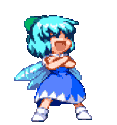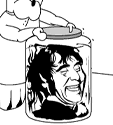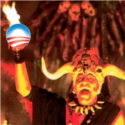|
So does anybody know anything about Rappan Athuk or Tome of Horrors Complete (the Swords and Wizardy versions, of course)? They both seem pretty awesome but $99 + shipping is pretty steep sight unseen! Edit: I read this of Rappan Athuk and SavageMessiah fucked around with this message at 20:56 on Sep 11, 2012 |
|
|
|

|
| # ? May 16, 2024 06:16 |
|
SavageMessiah posted:So does anybody know anything about Rappan Athuk or Tome of Horrors Complete (the Swords and Wizardy versions, of course)? They both seem pretty awesome but $99 + shipping is pretty steep sight unseen! I played one session with Rappan Athuk, and enjoyedish it. It was pretty cruel (the first thing that happened in the game was we got torn to bits by gargoyles), and we never did find any of the keys to any of the entrances to the dungeon, but it had a fairly nice mood to it. It's being run in Pathfinder, and 3e is pretty unpopular with our larger group (including me, but the dungeon sounded interesting enough that I wanted to try it out), so the game's having trouble finding players, but if it survives I can maybe give you a more meaningful opinion in a few sessions. Any NYC goons want to try it out? The next session's scheduled for the 22nd.
|
|
|
|
Here's a really interesting tool for tracking things like the time it takes for a torch to burn, when you need to rest and when to check for wandering monsters. Looks handy to me, anyway.
|
|
|
|
Looks pretty cool. This one's not as fancy, but it works pretty well. And it's free. 
|
|
|
|
What I like about the circular one is that you could easily use it to track spell/buff time visually. If a spell lasts 5 turns, just place a marker five turns down the circle and done. It really has potential as a multi-purpose game tool.
|
|
|
|
I usually use extra D10 I have laying around and just write down on a sheet of paper the spell/light source, then count them down every turn.
|
|
|
|
So I'm preparing to run my first 1st Edition AD&D game in a two-session romp at the second half of the month. I'm still going through the amazing Dungeon Master's Guide, but I had some questions that I don't think I'll find the answers to within. Namely I'm concerned about balance. I'd like to have up to five players, but at the moment I only have three in my roster and there is a decent chance only two will ultimately be able to make it. The Pathfinder Core Rulebook and (I think) the 4th Edition D&D Dungeon Master's Guide cover the issue of encounter balance for parties of varying sizes and types. However, it looks like the closest consideration 1E makes in expressing notions of balance is the array of encounters spelled out in the random monster selection rules, and even then I'm kind of skeptical that it really considers notions of "fairness," as much as that may matter in a game like this. So I guess what I'm rambling about and asking is how I can be sure to make some suitably challenging encounters for two or three players. If it helps, I'm definitely aiming for a dungeon crawl sort of scenario, but since it's not an extended campaign I'll be aiming to give them some sort of short-term quest. Progression and exploration are not likely to be big motivators in the short term. EDIT: I forgot to mention that this will be the first 1E game for any of us. I don't know if that's relevant. I don't know what's relevant at all in this drat game. 100 degrees Calcium fucked around with this message at 19:55 on Oct 7, 2012 |
|
|
|
Evil Sagan posted:So I'm preparing to run my first 1st Edition AD&D game in a two-session romp at the second half of the month. I'm still going through the amazing Dungeon Master's Guide, but I had some questions that I don't think I'll find the answers to within. Balance in 1e is really tricky if you try to think of it the same way you'd think of it in 3/4e. Fights are really swingy and one result on the wandering monster chart can result in 1 goblin as easily as it can 8 goblins. The big answer I've found for it is to just make absolutely sure that there's no encounter the PCs 'need' to have. Give the dungeon multiple paths to their goal, and be extremely open to letting them make it past monsters they deem too tough via methods other than combat; a troll is way too drat tough for a first level party to fight, but a troll they've lured in a closet that they then barricaded with heavy stone sarcophagi is just as defeated as one they reduced to 0hp and lit on fire. Hell, a troll that chased the party out of the dungeon the first time they met it, but that they snuck past as it slept the next day is just as defeated as one they killed. Every monster is a potential combat encounter, but it can also be a potential puzzle. Just avoid any situation where the players basically get told 'okay, well, you can either fight this dude or go home I guess' (other than maybe the setpiece final battle) and the unpredictable balance won't be an issue.
|
|
|
|
Evil Sagan posted:So I'm preparing to run my first 1st Edition AD&D game in a two-session romp at the second half of the month. I'm still going through the amazing Dungeon Master's Guide, but I had some questions that I don't think I'll find the answers to within. Keep in mind that older editions stressed hirelings and henchman. You were expected to have a full entourage of followers to help you out at lower levels. Many beginning modules like Keep on the Borderlands would have a page devoted to the random mercenaries chilling at the local tavern.
|
|
|
|
Good to know. I better review the rules on hirelings and henchmen and stress their availability. I only breezed through that part, so I assumed those were guys you hired when you started getting some surplus cash.
|
|
|
|
Summer is here and that means University is almost over. I'm going to start up an old school game with some friends. I'm thinking OD&D, only because statting poo poo up is insanely easy. Can anybody recommend any good OSR blogs that aren't full of terrible and inane whinging about how to play "properly"?
|
|
|
|
Dear You posted:Summer is here and that means University is almost over. I'm going to start up an old school game with some friends. I'm thinking OD&D, only because statting poo poo up is insanely easy. All the OSR blogs I've found with the best advice are the ones with the worst tone, sadly. What type of game are you thinking of running?
|
|
|
|
OtspIII posted:All the OSR blogs I've found with the best advice are the ones with the worst tone, sadly. What type of game are you thinking of running? Hm, I was afraid of that. I'm not too sure what can be done, which is why I'm searching for ideas, or what would be fun. Any suggestions would be greatly appreciated, if you have any.
|
|
|
|
Dear You posted:Hm, I was afraid of that. I'm not too sure what can be done, which is why I'm searching for ideas, or what would be fun. Any suggestions would be greatly appreciated, if you have any. To me, 'old school gaming' is all about empowering the players to make meaningful choices (not that other modes of gaming aren't, but it takes an especially front seat position here). You, as a GM, do this by giving them a setting with meaningful and predictable consequences and letting them completely drive the action. Basically, you give them a fairly passive setting and let them write a story with it. Giving them a full-blown fantasy world is ridiculous, though, so you generally narrow the focus way down or use techniques to 'cheat' without actually harming the player experience. Here are a few ways people do that: Dungeon-Crawl: The part of the setting that's really developed are the dungeons. Since dungeons by their very natures restrict movement/perception/action it's easy to create a 'complete' little space in which you can absolutely guarantee that the players will run into lots of interesting stuff without you needing to secretly steer them into it. This can be as low or high prep as you want, since there are tons of free dungeons online you can just borrow (google 'One Page Dungeon' for a nice starting point). Also, if you really want to get into it you can hunt down and buy some old D&D modules--the good ones are basically just little maps full of cool poo poo that someone drew so you didn't have to. Hex-Crawl: A lot like the dungeon-crawl, but way less compressed and with less movement restrictions between the points of interest. Just draw up a map on some hex paper, think up something cool to exist in every slot, and let people loose on it. I'm still figuring out my philosophy on how to make these fun, but noted 'blogger with horrible tone' The Alexandrian has some really fantastic posts on running a hex-crawl. These have a bit more pre-campaign prep work, but tend to be very low maintenance once you've started running it. City-Crawl: These are tough. Vornheim, by another blogger with a tone that drives people crazy, Zak S., is pretty good at getting you set up for one of those, though. Megadungeon: Like a dungeon crawl, but you build the entire campaign around one giant one that they're meant to slowly map out over hundreds of visits. These actually end up functioning pretty differently than normal dungeons since they need a few extra techniques applied to them to keep them engaging, but they're actually my personal favorite type of campaign. I can go way deeper into this if you're interested, since the game I'm running currently is based around one. gently caress It, Just Ask The Dice Things: This isn't so much a campaign style as a GM-technique. Since the GM is generally sole creator of the setting it's real easy to end up with some pretty ugly GM-fiat. To mitigate this somewhat you try to avoid making flat declarations when moments of setting ambiguity and instead just set odds that you roll on instead to decide what the PCs find as they explore the setting. When they try to find shelter from the elements in a cave instead of asking yourself "do I feel like loving them over with a monster who already lives there? Y/N?" you ask yourself "what are the odds the cave is already inhabited", decide there's a 30% chance it's a monster lair, and slap a monster in there if you roll a 8+ on a d10. Also, this blog post by Zak S. remains one of the best I've seen on the topic of different styles of campaign setting and how they inform player agency. Oof, I stayed up way too late writing this. I can get deeper into any of these if you're interested, but I'm worried that I'm already maybe losing some clarity to sleep deprivation so I'll leave it at this for now. Edit: Oh, I guess there's also stuff like Traveler-style merchant-crawling, but I know very little about that.
|
|
|
|
I should head out to the garage and see if i can find my basic books. I think i am only missing the immortals box  I also fear that the greenish box contains more porn mags than anything else. So if i can find these boxes it will be a double score of sorts. Has it really been a few decades? I do feel old now.
|
|
|
|
To be honest, I'm not sure I would run it in a trad way, I've already got some basic houserules worked out that change things quite a bit. This is very helpful though, thank you. I'm already getting some ideas peculating, I'm not typically worried about playing into insane levels but what do you think is a more polished starting point, whitebox or RC? I'd be using their respective clones.OtspIII posted:City-Crawl: These are tough. Vornheim, by another blogger with a tone that drives people crazy, Zak S., is pretty good at getting you set up for one of those, though. These are what interest me most. My idea for a setting works with either option. Is it possible to combine the two approaches? I can't really see how going back to the same dungeon would be fun, so I'm pretty interested in unpacking that.
|
|
|
|
Dear You posted:To be honest, I'm not sure I would run it in a trad way, I've already got some basic houserules worked out that change things quite a bit. This is very helpful though, thank you. I'm already getting some ideas peculating, I'm not typically worried about playing into insane levels but what do you think is a more polished starting point, whitebox or RC? I'd be using their respective clones. My favorite is Moldvay Red Box, and I'm not really familiar with the particulars of White Box (a guy in my group runs it monthly, but it's so houseruled I'm not sure what's him and what's the system and I've only played in it once), but RC seems really solid. Dear You posted:These are what interest me most. My idea for a setting works with either option. Is it possible to combine the two approaches? I can't really see how going back to the same dungeon would be fun, so I'm pretty interested in unpacking that. That's actually more or less what I do for my campaign, and I'm really happy with how it works. The dungeon is a place to get money and is full of danger, hardship, and constraints (which only exist to be overcome, of course), while the city offsets it by being a place where the players can spend their newfound cash to actually get poo poo done in a much more free-form and collaborative-worldbuildingish fashion. They play off each other really well, where the cities are sandboxes for the players to do whatever they want in, but whatever they do is going to end up costing huge amounts of money that they can only really get from raiding the dungeon. Here are a few of the things I try to do/think about for each of the two: The City Tables and Tables and Tables: Designing a whole city is too much work, but completely coming up with it as you go along is too hard. Make a bunch of lists of names for people/places, lists of jobs people might have, lists of personality quirks for NPCs/neighborhoods, and so on, so you can keep a nice balance between flexibility and preparation. I try to keep a list of 10 of each of these things on hand, and whenever I end up using an entry I erase it and write a new one in its place when I'm prepping for the next session. Weekly Events: One of the d10 tables I keep is a 'weekly events' table, that's just made of 10 notable things that people might be talking about having just happened in the city. At the end of each session I roll on it, tell the players what happens, and tell them that if they want to investigate it next week they should let me know so I can turn it into an actual session. It's a nice little way to give the players tons of low-prep plot hooks that they are under no obligation to pursue (maintaining full player agency in a way that normal plot hook delivery methods can easily erode somewhat), but then to also have fully fleshed sessions ready for them when they do bite. There's actually a little bit more to it than that, where it ties into the rumor system, but I just posted about that in my game thread so I'll just link that post instead of retyping it. Carousing/Socializing/Integrating Rules: One of the big things your players are going to want to do is get in cozy with existing city factions. I made some quick and easy rules for doing this, where how much money you spend schmoozing compared to how important the people you're trying to impress are determines your odds of making contacts. Again, I've already written that up elsewhere, so here's a link to my wiki. The Megadungeon First off, my DM for my IRL weekly game just wrote a few blog posts about megadungeon design. It's still in progress, but here it is so far. I'll probably repeat some of it, but it's a nice read. Mini-Setting: First off, megadungeons do risk being a bit boring if done as just a really big dungeon. Keep in mind that it should be a little setting in and of itself, full of factions and potential allies and non-hostile NPCs who could none the less be big liabilities to the party if interacted with wrong. Monsters who are willing to talk the the party instead of (or before?) eating them are good dungeon design in general, but it's especially important in a megadungeon. The party should probably spend at least as much time talking to dungeon citizens as they do killing them. Living Dungeon: Also, it shouldn't be static. Areas the players have cleared out will sometimes be restocked as new monsters move in. Killing the goblin chieftan on the first level of the dungeon gives the gnolls on the second level a chance to try to expand their influence. Other adventurers show up and threaten to loot rooms before the players do if they PCs start slacking off (although keep a very, very light touch with this--it lights a fire under the asses of the players that's fun in small quantities but turns horrific very quickly). The PCs go back to the same location over and over again, but that doesn't mean they need to go to the same situation over and over again. Interconnectedness: Freedom of motion is a huge part of dungeon crawling, but it's already incredibly restricted by just the fact that the players don't know where anything is. It's a good idea to make the map as non-linear as possible, so that once the players do know their way around they can move through the areas they've already explored very quickly, but so that it still takes a long time to fully explore any given level. Choke points can be good, since they end up opening up big new unexplored sections of the dungeon when they are finally found, but shouldn't be excessive. The most convenient paths between parts of the dungeon should often be blocked by especially dangerous monsters/hidden by secret doors/etc, so they can be slowly unlocked as the players explore and conquer their way through the dungeon. Don't be shy with passages to lower levels, either, as the natural danger will be plenty to keep your players from going too deep too quickly anyway. Mapping: Unlike one or two-shot dungeons, mapping is amazingly important to Megadungeon play. Mapping is crazy fun, but also not for everyone, so it's a good idea to figure out early on if you have someone who really wants to do it or if you should just hand-wave moving from one part of the already-explored dungeon to another. I picked up the mapping mantel from my group around maybe six months ago and its become easily my favorite part of the game. Here's an example of what a player map from about three years into a campaign starts to look like. Treasure Metrics: In general you want each level of the dungeon to roughly correspond to the level of the players exploring it, and since a megadungeon is meant to be able to take the party from 1st to last level by itself you can have a pretty good idea of how much treasure you need to have on every level (assuming you're using a gp=xp system). In general you can expect maybe 40-50% of the gold/xp you put in a dungeon to be wasted by character death or never being found or whatever, so to figure out how much gold to put on a level you can pretty much just figure out how much XP your party needs to level up and double it. To figure out the number of rooms a dungeon should have you can just multiply the number of sessions you want them to level up by the number of rooms you think they'll clear per session. Stocking: This is more generic dungeon advice than megadungeon-specific, but a good density guide to what should be in a dungeon is this: One third of all rooms should contain a monster (potential ally or not). One third should contain some sort of interactive thing like a trap or a magic fountain or a secret door or a puzzle. Another third should just be empty (and by empty I mean full of flavorful descriptions, but nothing the players are expected to actually spend time interacting with). Of those monsters half should have treasure. Of your special rooms about one third should have treasure. Of your empty rooms about one in six should have treasure. This balance seems best to me at keeping things tense and fresh.
|
|
|
|
Speaking of megadungeons, Rapan Athuk is out. As soon as the S&W reprint is out I think I might get both of these and torment my friends with some old school stuff. It'll be a nice change of pace for prep work to be making poo poo up instead of crunching numbers and suchlike.
|
|
|
|
This is good stuff man, thank you. Just two more questions and I think I've got enough to start out. Are there any good resources on mapping or is it something you just get better at with practice? Are there any rules of thumb to balancing out fights or is this also something you just gotta' feel out?
|
|
|
|
As it hadn't been posted I thought I'd post this, for some old old school. http://www.velvet-edge.com/Rythlondar.pdf This is basically a typewritten chronicle of weekly D&D games from the 70's. It'd follow the Dungeon Crawl aspect, I think, until they hit higher levels and go into outdoor adventures. Which means it's basically a prototype for BECMI.
|
|
|
|
ProfessorCirno posted:As it hadn't been posted I thought I'd post this, for some old old school. I WAS JUST THINKING ABOUT THIS LAST NIGHT. It is uncanny. I had been reading it and thinking it was cool a month or so ago before my old laptop died, and forgot where I had found it. It is some neat stuff, thanks for this.
|
|
|
|
Dear You posted:This is good stuff man, thank you. Just two more questions and I think I've got enough to start out. Are there any good resources on mapping or is it something you just get better at with practice? Are there any rules of thumb to balancing out fights or is this also something you just gotta' feel out? If you're doing the traditional mapping on graph paper thing, it can help if the DM and players come up with a standardised way of describing rooms, like always giving the north/south distance then the east/west distance, using simple language and describing things in the same order, so it might be Dimensions, Entrance location, Passage exits, Doors, Notable features, Contents. quote:<battle ensues> That gets the oldschool mapping out of the way with a minimum of fuss.
|
|
|
|
Dear You posted:This is good stuff man, thank you. Just two more questions and I think I've got enough to start out. Are there any good resources on mapping or is it something you just get better at with practice? Are there any rules of thumb to balancing out fights or is this also something you just gotta' feel out? I'm still learning how to balance fights myself, but it isn't nearly as important as it is in other editions if you're not a jerk about letting the PCs evade/negotiate out of/flee fights (as in, maybe throw in some complications or costs, but never just make not having a fight impossible) and the PCs will be able to choose their own fights, making having a large range of different difficulties a good thing rather than a bad one. They can always just come back when they're higher level if the monster's guarding an especially tempting hoard/passageway. Also, with the comparative lack of healing in the game and no encounter powers the power level of the group itself varies wildly from moment to moment. For your first fight of the day a party of 5th level characters will have high HP and lots of options for support spells/etc, but by your fourth you might be looking at a party that's all at 6-10ish HP and has only one or two low level spells at their disposal--in other words identical to a first level party. It's hard to balance fights because it's hard to know how strong they'll be at any point of the session. The good news is that even a moderately easy fight has the chance to knock off a dozen or so HP from the party, making every further fight harder and rendering that first fight still tense. I guess my last note is that I always overestimate high level creatures--fights with things like dragons or a single troll can be very swingy for low level creatures--they'll just mob them, nail them with all their best spells, and very often kill what you thought was a creature about 4 levels over their capabilities in a round or two, but then go back and almost party wipe against 4 level-appropriate cougars. Pay a lot of attention not only to the toughness of the creatures you place, but also their numbers. Also, Rythlondar is amazing, thanks!
|
|
|
|
About the whole level appropriateness thing, older D&D was more about evading traps and fighting random low-mid level monsters most of the time, with tougher monsters being saved for boss fights and such. Try adding in more puzzles and traps, with appropriate XP rewards equivalent to the monster encounter you may have planned for that section of the adventure. You may be surprised at the results.  By the way, everyone should have Grognardia and Gnome Stew bookmarked. Grognardia is run by a dedicated old school RPG fan, and he's not a stuck-up douchebag! Gnome Stew is the best resource on the internet for DMs and is very highly recommended. Silhouette fucked around with this message at 16:44 on Nov 3, 2012 |
|
|
|
Which version of OD&D came in a bunch of folders (for lack of a better word). I'm remembering something from high school and it's a bit hazy.
|
|
|
|
jadarx posted:Which version of OD&D came in a bunch of folders (for lack of a better word). I'm remembering something from high school and it's a bit hazy. Could you be thinking of 2e monster manual stuff? Where each monster was just on a Wildlife Fact File-esque piece of 3-hold punched paper so you could add supplements you bought directly to your main file? Because now there was an idea that's brilliant in a world full of digital tablets but godawful in the 90's if ever I heard one. Also, Basic and Expert and so on came out in 64-page so-softcover-they're-almost-ashcan 3-hole punched booklets in at least some versions, which I legit love and wish more campaign-centric RPGs would do. Oh, and I forgot one general RPG tip that's especially useful for any campaign where you're going to be doing a lot of impromptu worldbuilding--make a d666 chart of just cool concepts and moods and so on, then whenever you want inspiration for what should be in a hex/what type of personality a NPC should have/etc just roll on it twice and try to rationalize the interaction of the concepts into something cool. I fall into ruts really easily when trying to come up with too many ideas at once or if I'm improvising, so having a way to force me to mix it up is invaluable. I divided mine into six sub-sections, so I can just roll a d66 if I need a more targeted burst of inspiration. They're Personality Traits, Problems/Conflicts, Primal/Wilderness, Civilization, Artists/Genres To Style-Emulate, and Misc. Here's my personal list, but since each campaign is going to have a different style I figure each campaign should have its own: 
|
|
|
|
I liked the monstrous compendium and adding new sheets to my binder.
|
|
|
|
OtspIII posted:Could you be thinking of 2e monster manual stuff? Where each monster was just on a Wildlife Fact File-esque piece of 3-hold punched paper so you could add supplements you bought directly to your main file? Because now there was an idea that's brilliant in a world full of digital tablets but godawful in the 90's if ever I heard one. It was not monster stuff. It may have been a collection of other products. I didn't really know much about dnd at that time, I just remember looking at it. It seemed to me that everything, down to the 'folders/portfolio', were official. But I could be mis-remembering.
|
|
|
|
jadarx posted:It was not monster stuff. It may have been a collection of other products. I didn't really know much about dnd at that time, I just remember looking at it. It seemed to me that everything, down to the 'folders/portfolio', were official. But I could be mis-remembering. Some people would actually razor the pages out of the rulebooks and re-bind them either in hole-punched folder format, spiral binding, or into a new and "better" cover. Why? gently caress if I know, my 1st ed AD&D books are some of the sturdiest books I've ever seen.
|
|
|
|
PeterWeller posted:I liked the monstrous compendium and adding new sheets to my binder. Of course TSR hosed up half the point of the concept (organizing all your monsters in an easily-accessible alphabetical format) by printing different monsters on the front and back of the same page. They did eventually get that part right a couple years later... not in D&D, but in the binder-based character sourcebooks for the Marvel RPG.
|
|
|
|
Yeah, the big Mead binder I used ended up being only roughly alphabetized. But in TSR's defense, the big Mead I kept all my Btech record sheets in ended up the same way.
|
|
|
|
jadarx posted:Which version of OD&D came in a bunch of folders (for lack of a better word). I'm remembering something from high school and it's a bit hazy. That's Black Box Basic D&D, the 'NEW, EASIER TO LEARN' version with the red dragon on the cover. It came with a few miniatures, the tabbed folders full of rules and an adventure with a giant map/combat board of a wizard's tower.
|
|
|
|
Silhouette posted:That's Black Box Basic D&D, the 'NEW, EASIER TO LEARN' version with the red dragon on the cover. It came with a few miniatures, the tabbed folders full of rules and an adventure with a giant map/combat board of a wizard's tower. Yes, that was it. Thanks.
|
|
|
|
Silhouette posted:That's Black Box Basic D&D, the 'NEW, EASIER TO LEARN' version with the red dragon on the cover. It came with a few miniatures, the tabbed folders full of rules and an adventure with a giant map/combat board of a wizard's tower. Black Box was ostensibly intended as a starter set to get people into Rules Cyclopedia D&D. The line of adventures beginning with Thunder Rift used the Black Box rules and were meant to bridge the gap between the two games, and "Challenger Series" products like the Creature Catalogue used the Cyclopedia's rules in full. There was also another revision of the same boxed set in 1994, retitled "The Classic Dungeons & Dragons Game", which reformatted the Black Box's text into one book and which was in the standard RPG boxed set size instead of in board game size like the Black Box. Of course the outside of the box didn't note that the whole thing was essentially a reprint, unlike the 2e PHB/DMG reprints that came out around the same time.
|
|
|
|
I had a copy of the Black Box in the boardgame size with a single softbound rulebook instead of the folders. This is the first I've heard of those. I'm pretty sure it came out before Thunder Rift. I also had that 2E starter set that was in a blue box, I think. It was called First Quest or something, and it came with a CD. I remember the adventures in it were kind of cool, going from a classic dungeon crawl to a RL style haunted manor to some asteroid or something involving a wrecked Spelljammer ship.
|
|
|
|
...
Nostalgia4ColdWar fucked around with this message at 04:38 on Mar 31, 2017 |
|
|
|
I'm thinking about running a 1e AD&D campaign with my usual irc/roll20 group, keeping as by the books as possible. What books beyond the DMG/PHB/MM are particularly useful and which ones should I really avoid? Also any recommendations on early adventure mods? I was thinking of going into a more open ended campaign or a hexcrawl after getting used to the system, but want to start with something premade first since I haven't played this edition before.
|
|
|
|
|
Dungeoneer's/Wilderness Survival Guides. Fiend Folio is good if you need some weirdo monsters, and Deities & Demigods is worth reading if you want to literally throw Cthulhu at your players. Unearthed Arcana has a bunch of weird new rules if you want to change some things, and was considered by Gygax to be the "real" 2nd edition (thankfully it wasn't). And for
|
|
|
Silhouette posted:Dungeoneer's/Wilderness Survival Guides. Fiend Folio is good if you need some weirdo monsters, and Deities & Demigods is worth reading if you want to literally throw Cthulhu at your players. Unearthed Arcana has a bunch of weird new rules if you want to change some things, and was considered by Gygax to be the "real" 2nd edition (thankfully it wasn't). Thanks. Also is Ravenloft a setting where a campaign should start in if I run that later, or is it something I can transport players to at a higher level?
|
|
|
|
|

|
| # ? May 16, 2024 06:16 |
|
Zerilan posted:Thanks. Also is Ravenloft a setting where a campaign should start in if I run that later, or is it something I can transport players to at a higher level? A big part of Ravenloft's conceit is that the adventurers are all somehow brought there from other dimensions and can't leave until they beat the castle or whatever, so that sounds good. Keep in mind that (good) 1e modules are more locations than plots, so they're actually better for a sandboxy game than they are as things that create storyplot. I've played B1, B2, and T1 and enjoyed them all--more or less. In Search of the Unknown has a reputation with my group for being frustrating and bloody, and so we all hate it with a passion (in a kind of a good way?), but that's probably more our personal experiences with it than anything else (we had a few moments of bad bad luck there). Honestly, I'm not sure how hard I recommend any of the books outside of core. Fiend Folio monsters are kind of bad in play most of the time and there's very little in any sourcebook you probably can't make up for yourself and have it mesh way better with your game and group.
|
|
|



























